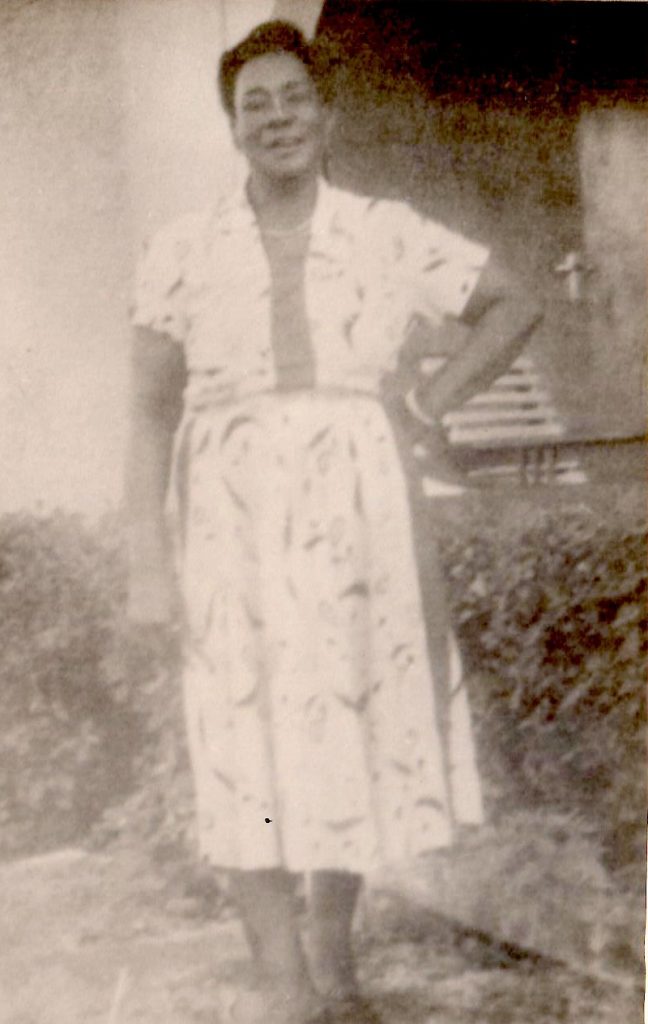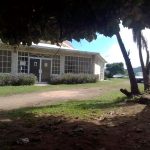
Things were going well for the Hall family. ‘West’ as she was fondly called by her husband, was an extremely hard worker, a creative woman, exemplary mother. Samuel was a dedicated farmer. He planted yams and sweet potatoes which he sold to higglers at farm gate prices; tobacco which he sold to agents of the Tobacco Company of Jamaica and oranges and grapefruit which he sold to the Jamaica Citrus Company. In those days, oranges were sold primarily for the oil from the skin, not for the fruit. There was a small ‘factory’ in the community where ‘rhinding’, or the separation of the oil from the skin of the fruit was done for use in the cosmetics industry.
Coffee picking time was exciting. After the adults reaped the ripe beans, the children would go under the trees and pick up ‘rat cut coffee,’ seeds scattered after rats consumed the juice from the ripe berries. Rat cut coffee was washed in the coffee pulper, dried on the barbecue, parched, beaten in a wooden mortar until it became powdery and was then stored in metal cans for home consumption. Early morning tea could be any of three hot drinks – coffee tea, bush tea, or cocoa tea.
Everyone planted a variety of fruits, vegetables and ground provisions for domestic consumption; reared cows for milk and eventual sale to the community butcher, goats for milk and meat, and the inevitable collection of myriad breeds of chicken – from the game cock to the wild-looking sense fowl. It was no compliment when girls were told, “Yu head fava sense fowl!”
No one bought cigarettes. Smokers in those days made their own cigars, prepared their own pipe mix, or bought from the tobacco ‘rope’ sold in the market.. Liberated women smoked head-to-head with men. Auntie my grand aunt was a tall, pencil thin, elegant woman who could have been a model at a snap today, was never without her pipe. Not only was she an inveterate smoker, she turned her white chalk pipe inside out, with the bowl of the pipe in her mouth and the stem outside!
Samuel and West were community folk. West was a dedicated Moravian and played for her church. Later she switched her faith to the Seventh Day Adventist. Paradoxically, all the children were confirmed Anglicans. Samuel was a well-respected citizen of Hillside and a Special Constable. Celeste, his fourth child described him thus: Dad was a tall, handsome man and a sharp dresser, especially when he went to church and rode his horse to his Lodge meetings in Mandeville. He was a big time farmer who had many properties and employed several workers who he treated with love and respect. He believed in the importance of family. He loved his children and looked after his younger brother and sisters and their children, especially Aunt Caroline “Auntie” who lived neaby .He was also a good cook as every Friday he gave Mama a break from the kitchen and cooked dinner for us all. On Saturday evenings he cleaned all our shoes for church on Sunday.

As more children arrived and demands for economic viability grew, Samuel and West expanded their land holdings with two properties named for the previous owners – Johnny, adjacent to the family was bought from Johnny Blackwood. Jones, a stone’s throw away was bought from Ernest Jones, my great grandmother’s brother. Everyone had to actively participate in the running of the farm and the household.
Life was good for the Halls. But the good times did not last. At age 51, on a busy Saturday night, Samuel was viciously stabbed in his shop by a drunken butcher whose disorderly conduct he had tried to quell. On Sunday morning his body was found floating in the community tank. He never recovered from the attack and died nine months later. At 41, West was left with nine children to rear on her own. The youngest was nine months old.
Samuel and Any were strong advocates of education, which they regarded as a basic requirement for acquiring a life skill, a tradition religiously followed even after he died, and the fortunes of the family changed dramatically.
So, after completing primary, in those days government school, the older girls and boys were apprenticed to become dressmakers, hairdressers and carpenters. The middle siblings were more fortunate. They became teachers and nurses. The youngest child, a girl, obtained a university education. I was also the beneficiary of their emphasis on education. My love for reading can be fully attributed to my grandmother. I remember the daily ritual of reading’ the Gleaner – synonym for newspaper – to her. When I went to government school at age seven, I was reading beyond my age.
I lived in what to a small child was a big sprawling house with many adults who were always coming and going. Ivy Cottage had five bedrooms, a living or ‘drawing room’ as it was called in those days, bathroom, kitchen, buttery and an outside toilet. The organ had pride of place in the drawing room, It was always covered with an elaborately decorated silver cloth with metallic tassels, gracing the drawing room, along with a three-piece settee with curved wooden arms. Family photographs hung proudly on the walls and the ‘china cabinet’ where my grandmother kept her special china imported from Staffordshire, England, on display. I was carefully taught the names of the various pieces of china and from those early days could recognize a bread plate from a dinner plate, a saucer from a side plate, soup and porridge bowls, milk jug, sugar bowl, coffee pot and a tea pot; while for silverware, the teaspoon, tablespoon, serving spoon and the serrated, sharp-pointed grapefruit spoon that I used to delight in using to separate the fat, juicy flesh from the bitter rind and skin.
All the girls were required to learn the organ, starting with the English Smallwoods Manual. I too had my stint on Smallwoods with the attendant ‘conks’ on my forehead when I touched the wrong key, or when she was not sitting beside me, the impatient shout “B-flat, not F-sharp child!”
A double wooden door separated the dining room from the drawing room. Its centrepiece was a long mahogany table with ten chairs. There was a safe with fine meshing at the top in which the everyday china and glasses were kept, and the enclosed, wooden section at the bottom for groceries. To the left of the safe was a small table on which sat the earthen ware water jar,
A window beside the table looked out to the kitchen and buttery below. Another set of double doors opened onto a small landing with concrete steps leading to the kitchen and the backyard.
The concrete-floored kitchen was furnished with a state-of-the-art Caledonia Dover cast-iron, wood burning stove, a table which served as a counter-top and underneath a place for pots. The kitchen had two windows, one opened onto a cho-cho arbor, while the other looked over a huge avocado tree (pear to all of us until migration and the ‘discovery’ of the English and American pear) that bore shiny-skinned, long-necked pears with incredibly thick flesh which I loved to eat with my bulla, and a scotch bonnet pepper tree that never died.
The story is told that when I was a toddler, there was a bird pepper tree in the same spot. I was attracted to the bright red peppers and promptly scrambled over and helped myself to them. Verley, one of my grandmother’s many adopted children who was supposed to be minding me had wandered off, only to hear my terrified screams when the burning started. He tried to lift me away from the tree, but I fought back and got pepper juice on him also. The end result was a bawling, screaming toddler and a slightly older child also in tears from the burning effects of self-administered bird pepper ointment.
The buttery, attached to the kitchen but with its own front door, contained dried corn to be planted, yam for cooking, yam heads to be planted; the big mortar for pounding roasted coffee beans into ground coffee, crocus bags, current and discarded planting tools – forks, hoes, spades, pick axes, pieces of rope, twine, broken water jugs, calabashes. When my grandfather was alive and planted tobacco at nearby Cedar Grove, the ceiling had strips of wood stretched across the entire length of the room on which tobacco leaves were hung for drying. The rear window of the buttery looked out onto ackee and guava trees on land that sloped gently to the stone wall that separated Ivy Cottage from neighbouring Wreslyn , before rising sharply uphill.
The verandah ran the full length of the house. Like the bathroom, it had a red-stained concrete floor, cut into squares to look like tiles. The rest of the floors in the house were made of a rich, dark brown wood that had to be shined by the coconut brush “till yu see yu face in it.” The verandah was furnished with sloping, wooden chairs and a small table on which visitors could place their drinks. The bathroom consisted of a concrete basin and bath. The toilet, latrine or outhouse outside was discreetly placed beside a naseberry tree that had the juiciest, sweetest berries in the yard.
Immediately outside the bathroom was a huge lemon tree, about five ft. high that was trimmed in the shape of a mushroom, and on which wash rages, and bath towels were spread every day after your morning bath. The red earth of Hillside may have been rich in bauxite, but it stained everything in which it came in contact. Bathing or ‘washing up’ twice per day was therefore a necessity, as was the sheet of zinc for bleaching, permanently mounted on a wooden frame, beside the clothes line to the left of the lemon tree.
The house was built with cellars, damp, indescribably dusty, dark and frightening recesses that, since I was the youngest in the household, it became my job to collect the eggs the hens invariably laid there. I crept on all fours like a crab and felt for the nests, sometimes assisted by the rays of sunlight that shone through the space between the wooden floors and the dusty red earth of the cellar. There was always the fear of having a confrontation with a hen guarding her eggs, a frog which I hated, scorpions, gallowasps, or even spiders. I hated them all with a passion.
Ivy Cottage had two barbecues to the right side of the house. The coffee pulper was attached to the smaller one, while the guttering around the house for harvesting ‘rain water’ emptied onto the larger one which in turn emptied into the mesh- covered water tank. This was the multi-purpose barbecue, used for drying peas, yams, corn, and the overflow of coffee from the small barbecue. There was a clear path from the back step to the tank and past the otahiti apple tree to the stone wall that separated Johnny from Ivy Cottage. On either side of this track were the coffee patch, and a veritable forest of fruit trees of every size and description – orange, grapefruit, tangerine, lime, lemon, and breadfruit. It was under this canopy that my aunts and uncles – as children – gathered their rat cut coffee. Home birth was the custom then , so some of these trees were ‘navel trees’ named for the newborn whose placenta was buried and a tree planted on the spot.
Unlike the rest of the family, I was born at the Hargreaves Maternity Hospital in Mandeville, and was therefore ‘deprived’ the pride of my special ‘navel tree.’ and the accompanying bragging rites when my navel fruit tree bore profusely.
So where was Ivy Cottage? Half -a-mile from the West Indies Training College, now the Northern Caribbean University, and immediately after passing Good Luck Gully, up a slight incline, on the right side of the road were two curved, white cut stone walls, decorated with bold black veins framing a white-painted wooden gate, where the name of the house painted in black on either side of the gate, announced that you had arrived at Ivy Cottage. Paradoxically, there was no ivy growing anywhere. The double gate opened onto a dual pathway, snaking on either side to the back of the house. In the middle was a V-shaped garden, with multi-coloured perennials and a trailing pink and white rose plant.
To the right of the gate were gladiolas, dahlias and gold and brown honeysuckles on the low stone wall separating the garden from the ‘coffee piece.’ An entwined custard apple and tangerine tree grew against the edge of a small barbecue with the coffee pulper. To the left were two huge navel orange trees and a cornucopia of annuals and perennials. The overall appearance was that of a typical rural English garden where everything grew together in lush, abundant confusion.
Miss Amy, as the community now called her (West was reserved for her departed husband) was a fine figure of a woman. Medium height, on the buxom side, with the lush ripe body of the portraits of the 16th. Century Dutch artist Peter Paul Rubens. She walked with an upright gait, her waist cinched with one of her son’s discarded Scout belts.. Her thick black hair, always combed in an upsweep, flashing brown eyes, lopsided smile and easy manner endeared her to all with whom she interacted. My earliest recollections of my grandmother are of a large kindly woman who was always laughing with me, lifting me up, hugging me, patting my hair, holding fish eyes between her thumb and index finger for me to suck to give me brains.
I distinctly remember sleeping in my grandmother’s bed, high up and behind her on the side of the bed beside the wall so I would not fall off. I also remember waking in the nights against her back, with cramps in the arm closest to her. Even as I complained about the cramps, I could not be taken from my Grandmother’s bed. . It was not until I was much older that I realised her weight had dipped the mattress and left me on a type of perch.
Miss Amy was the leader in the community. She was godmother to many children. She was guidance counsellor to problem children. Sometimes she became the adopted mother, taking in many abandoned children on top of her brood. She was consulted when young men wished to take a wife, when a business arrangement was to be forged, when someone wanted a loan, or wanted to rear a cow or pig in partnership with her.
At Easter and Christmas she baked buns and puddings for the less fortunate in the community, and sent me to deliver them. She was the largest employer of farm hands. Today, she would have been a cinch for the Governor General’s Award for outstanding community service.
Her house was where political aspirants were advised to visit, where the Anglican Minister had tea when his tour of the circuit took him to Hillside. The first politician’s name that I can recall was that of Lawton Broomfield, a tall, lanky man in glasses, who drove a black car. I remember my grandmother entertaining him in the ‘drawing room’ reserved for special guests, as against the verandah where all and sundry were welcome.
I remember my grandmother ‘s politeness to the gentleman, the caustic laughter she shared with my aunts and uncles at his departure and her derisive “Lawton Bloomfield really think sey me would a vote fi labour?” Lawton Bloomfield was the candidate for the Jamaica Labour Party led by Alexander Bustamante, in the national elections of 1949; while Wendel Benjamin was the candidate for the People’s National Party led by Norman Washington Manley, himself a Mancunian. Benjamin defeated Bloomfield. In my childish mind, anyone my grandmother disapproved was worthy of my disapproval, and in this case, his political party also. One should never underestimate the power of subliminal early childhood socialization. I was a mere seven years old at the time.
My grandmother had an unfortunate propensity to characterize persons of whom she disapproved as ‘ole nager.’ She did so emphatically and unapologetically at times, even to the individual’s face. I am told that one day, after a particularly unflattering description of the gentleman, I sidled up to her and asked, quite earnestly, apparently with a burning need for confirmation, “Mama don’t me and you are new nager?” Out of the mouth of babes!
To the small child, my home was a wonderful, almost magical place. I had everything in abundance. Love from the adults, especially my grandmother, books, although I could read only a few; fruits in abundance, tangerines, my favourite fruit in abundance, yard space in abundance, where I could freely wander with my loving dog Rover who followed me around. Life could not have been better for G-G as my grandmother fondly called me. But how long would my idyllic life, my age of innocence last?







